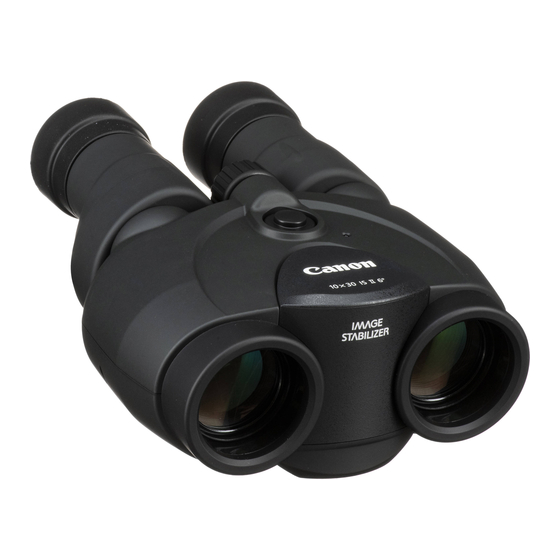Canon 10x30 IS II Manuel - Sayfa 20
Dijital Kamera Canon 10x30 IS II için çevrimiçi göz atın veya pdf Manuel indirin. Canon 10x30 IS II 25 sayfaları. Technology guide
Ayrıca Canon 10x30 IS II için: Broşür ve Teknik Özellikler (8 sayfalar), Broşür ve Teknik Özellikler (8 sayfalar), Kullanıcı Kılavuzu (2 sayfalar), Talimatlar Kılavuzu (13 sayfalar)

Various types and characteristics of image stabilization
technology
Presently, there are three makers, including Canon, selling
binoculars with image stabilization technology
1) Vari-Angle Prism type
Two sensors detect horizontal and vertical shaking respectively.
The two Vari-Angle Prisms in both the left and right telescopes
are controlled by a microprocessor to instantly adjust refraction
angle of the incoming light. This system is used in Canon' s IS
Binoculars.
Advantages:
Disadvantage: • Requires batteries.
2) Gyro type
A high-speed motor-driven gyroscope is attached to a prism.
No matter how much the binoculars are shaken, the image will
remain stable. This system is used in Fujinon' s Stabiscope S1240
and S1640.
Advantage:
Disadvantages: • One minute delay while the 12,000 rpm motor
3) Mechanical type
The prism system is tied-in with the Cardanic Suspension
system, which prevents the prisms from moving no matter how
much the binoculars are shaken. This system is used in the
Zeiss 20x60S Professional.
Advantages:
Disadvantages: • Tend to be heavy.
• Compact, light.
• Immediate response after the image stabilizer
is activated (the system is activated as soon
as the button is pressed).
• Stable image even when panning.
• Extremely resistant to heavy shaking or
movement.
is starting up.
• Tend to be heavy.
• This system is unable to distinguish between
shake and panning; therefore image is not
stable when panning.
• Requires batteries.
• No batteries required because of mechanical
system.
• Immediate response after the image stabilizer
is activated (the system is activated as soon
as the button is pressed).
• This system is unable to distinguish between
shake and panning; therefore the image is not
stable when panning.
